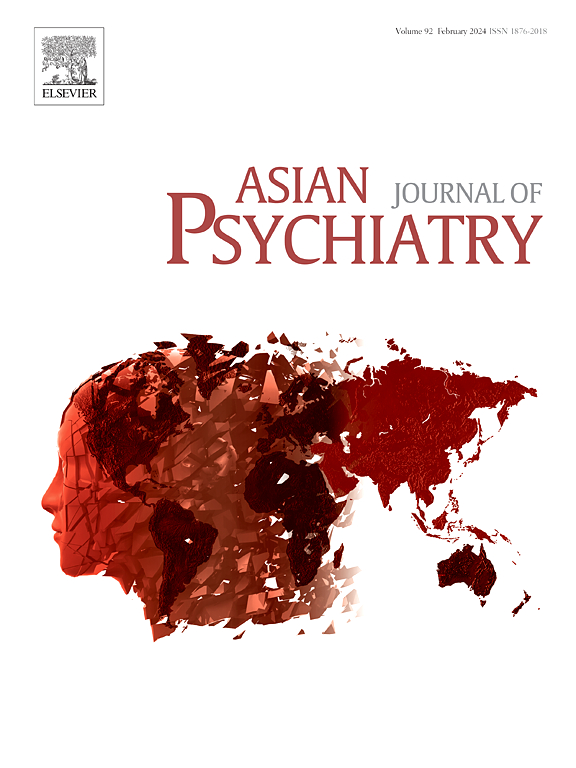代理感作为精神分裂症预测的临床可访问特征:可解释的集成机器学习研究和web服务器开发
IF 4.5
4区 医学
Q1 PSYCHIATRY
引用次数: 0
摘要
精神分裂症是一种高风险、高负担的精神疾病,其特点是病程长,残疾严重。准确的识别和早期干预可以减轻社会经济逆境,包括疾病引起的贫困和公共安全风险。传统的诊断主要依赖于结构化的临床访谈,临床医生使用阳性症状作为精神分裂症和相关疾病的关键诊断指标。机器学习驱动的计算机辅助诊断系统的最新进展已经成为一个变革性的前沿。这些系统可以有效地捕捉可量化特征与精神分裂症之间的相关性,不仅可以辅助诊断预测,还可以为临床治疗提供潜在的方向。值得注意的是,代理意识缺陷(SoA)是精神分裂症的一个核心特征;然而,基于SoA缺陷直接预测精神分裂症并量化其诊断意义仍然是关键的未解决的挑战。在这项工作中,招募了155名参与者,并开发了可解释的集成机器学习模型,以研究精神分裂症预测和可解释性分析的SoA特征。首先,采用机构评级、时间间隔估计和意向绑定等方法生成SoA特征。然后,训练六种基线机器学习算法,其中RF和TabPFN表现出最佳性能。为了进一步提高可靠性,实现了RF和TabPFN的集成建模策略,产生了高性能的分类器SchNet(准确率为0.90,F1-Score为0.91)。为了连接理论和实践,我们还部署了SchNet web服务器(https://github.com/jourmore/SchNet-webserver),提供SoA在线测试、精神分裂症风险预测和可解释性分析。该工具作为计算机研究和临床应用之间的转化桥梁,支持数据知情的精神分裂症治疗策略。本文章由计算机程序翻译,如有差异,请以英文原文为准。
Sense-of-agency as clinically accessible features for schizophrenia prediction: Interpretable ensemble machine learning research and webserver development
Schizophrenia is a high-risk, high-burden psychiatric disorder characterized by a prolonged course and severe disability. Accurate identification and early intervention can mitigate socioeconomic adversities, including illness-induced poverty and public safety risks. Traditional diagnosis relies predominantly on structured clinical interviews, with clinicians using positive symptoms as key diagnostic indicators for schizophrenia and related disorders. Recent advances in machine learning-driven computer-aided diagnostic systems have emerged as a transformative frontier. These systems can effectively capture correlations between quantifiable features and schizophrenia, enabling not only auxiliary diagnostic predictions but also providing potential directions for clinical treatment. Notably, deficits in sense of agency (SoA) represent a core feature of schizophrenia; however, directly predicting schizophrenia based on SoA deficits and quantifying their diagnostic significance remain critical unresolved challenges. In this work, one hundred and fifty-five participants were recruited, and interpretable ensemble machine learning models were developed to investigate the SoA features for schizophrenia prediction and interpretability analysis. First, agency rating, time interval estimation and intentional binding methods were used for SoA features generation. Then, six baseline machine learning algorithms were trained, with RF and TabPFN demonstrating optimal performance. To further enhance reliability, an ensemble modeling strategy with RF and TabPFN was implemented, yielding a high-performance classifier SchNet (Accuracy of 0.90, F1-Score of 0.91). To bridge theory and practice, we also deployed SchNet webserver (https://github.com/jourmore/SchNet-webserver), offering SoA test online, schizophrenia risk prediction and interpretability analysis. This tool serves as a translational bridge between computer research and clinical application, supporting data-informed therapeutic strategies for schizophrenia.
求助全文
通过发布文献求助,成功后即可免费获取论文全文。
去求助
来源期刊

Asian journal of psychiatry
Medicine-Psychiatry and Mental Health
CiteScore
12.70
自引率
5.30%
发文量
297
审稿时长
35 days
期刊介绍:
The Asian Journal of Psychiatry serves as a comprehensive resource for psychiatrists, mental health clinicians, neurologists, physicians, mental health students, and policymakers. Its goal is to facilitate the exchange of research findings and clinical practices between Asia and the global community. The journal focuses on psychiatric research relevant to Asia, covering preclinical, clinical, service system, and policy development topics. It also highlights the socio-cultural diversity of the region in relation to mental health.
 求助内容:
求助内容: 应助结果提醒方式:
应助结果提醒方式:


